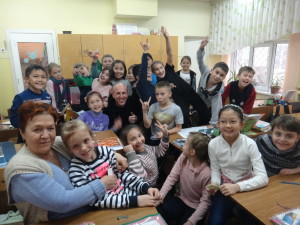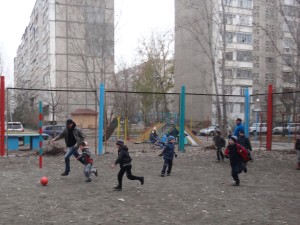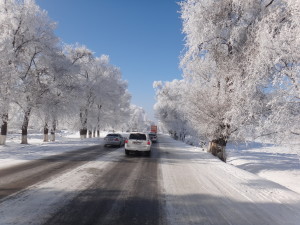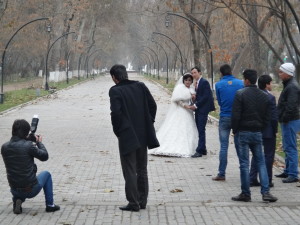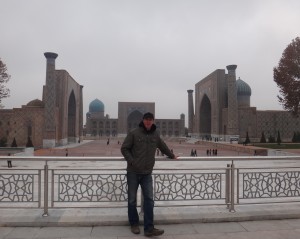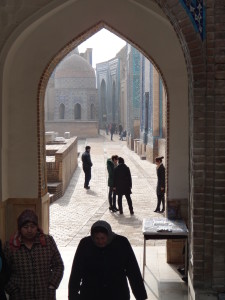Traversing The Stans
Kazakhstan and travelling south
November 19, 2014Malaysia, Part 1
December 4, 2014I went to the UNICEF office in Bishkek for a press conference about our event celebrating the 25th Anniversary for the Convention on the Rights of the Child. There was a good turnout of all the major media organisations in Kyrgyzstan. Joining me, were representatives from UNICEF, and a well known singer from Kyrgyzstan who was going to be singing ‘Imagine’ by John Lennon at the event.
The press conference lasted for around an hour, and covered topics such as the Anniversary of the CRC, what UNICEF do in Kyrgyzstan, the story behind the gifting of the ‘Imagine’ song to UNICEF by Yoko Ono, what my project is about, and the balloon.
I called the Uzbekistan Consulate to arrange an appointment to apply for a visa after the press conference, (you can’t just turn up there). They said to call later in the day.
That afternoon, I went with the Head of Communications to a school to talk to two classes of kids aged between six and nine about what I am doing, where I’m from and to inspire them to follow their dreams. The kids were very enthusiastic and asked me lots of questions.
I was invited to eat with the second class. They have snacks at certain times of the day in their classroom. A great idea I think.
I called the Uzbek Consulate after; they again said to call later.
The following day was spent doing general things, such as getting an adaptor made by a fitter and turner so I could refuel the balloon. I found a place to refuel and went to a workshop in the afternoon to service the truck. It was a bargain, less than $100 for an oil change and service.
I also finally managed to arrange an appointment to get our Uzbek visas. They made it for the following Tuesday. I was glad we had time to spare.
We also removed the tint from the windows as it is illegal to have the front side windows tinted in this part of the world. The police were giving us a lot of grief about it and we were stopped at almost every checkpoint. I had managed to talk our way out of it up until then, but I knew it was going to get worse in Uzbekistan and later. It was relatively easy to remove using a hair dryer and a sharp knife.
We went in convoy with a UNICEF vehicle to the school for the event the next day. There was still fog around as we travelled there, but it cleared as we arrived and the sun came out: A good sign.
I did a weather check and got the balloon ready to be inflated before the scheduled start time.
There was quite a crowd, around 800 kids, plus many more adults, including politicians and the First Lady of Kyrgyzstan. She gave a speech as well as some other ministers, the representative of UNICEF Kyrgyzstan and the school principal. There were a number of traditional dance performances by kids and dance troops. Many of the kids had dressed in traditional clothes, it was great to see.
I was the last to give a speech and spoke to all levels present. I encouraged the kids to follow their dreams, I asked the parents to nurture their childrens’ talents and suggested to the politicians present that they should be investing more in education as the children were the future of a greater Kyrgyzstan. It was a rare opportunity to be able to speak to all levels of society.
After my speech, we directed everyone to the school field. I had a quick interview with the numerous media present, and then proceeded to inflate the balloon. The crowd were amazed when the balloon was filled with hot air and stood up. I kept the balloon on the ground for a while so people could take photos and get a good look at it.
When I eventually took off, the cheer from the crowd was something else. Everyone was so excited, not only the children, but the adults were also jumping around. I was told after that even one of the politicians who is difficult to please, got very excited. They had never seen the person like that before.
As we took off, 500 helium filled balloons which were given to the kids, were also let go. All in all it was an amazing experience and maybe the nicest moment of the project so far.
I had a photographer flying with me so everything was captured. Lots of people asked if they could fly with me before we took off: the head of the Civil Aviation Authority, the First Lady, and various government ministers. I had to say no to them all. I can imagine “no” is an answer they wouldn’t hear often.
We flew over a cemetery. Some young guys were digging a grave. It must’ve brightened their day a bit. We also flew over the only golf course in the country. We flew for around 40 minutes and landed on a farm. Des and my local helpers were there when we landed.
Not only was it a great event, we had also created Kyrgyzstan history by being the first people to officially free-fly a balloon in Kyrgyzstan.
We went with Galina, (the Head of Communications for UNICEF) and her family to a nearby national park in the mountains the following day. The weather was great and we had a nice time walking in the mountains before returning to Bishkek to have a late lunch and played football with Galina’s two Sons and the rest of the neighbourhood kids for the rest of the afternoon. It was an enjoyable day.
Des and I went to the Uzbekistan Consulate at 9.30am the next day. The weather was cold and snowing and we sheltered under the roof of a nearby building until 10am, when the consulate opened. A woman came out at 10am and called out the names of those who had appointments. We had to remember our numbers because that was the order we would be seen in. Everyone had to wait in the freezing cold and snow as each person went in one by one. I can’t imagine having to wait there if it was -20deg, which it can be sometimes. -4deg and snow was bad enough.
We waited for around 45mins before we were seen. We must’ve looked like snowmen when we walked in. I hadn’t brought a photocopy of my passport, so I had to go around the corner to get one, then wait for another 25mins to be seen again.
We were issued our visas on the spot and we were happy to get out of there.
We walked to the UNICEF office after and went out with a couple of the communications team for lunch as we were leaving the next day. We were also shown a couple of articles which had come out in the paper about the event. There was lots of coverage in the news about the flight, many of the TV news programmes and newspapers had covered it.
We had an enjoyable lunch at a restaurant serving national dishes. It snowed a lot while we were there and I was glad we weren’t still waiting outside the Uzbekistan Consulate.
It was an icy -11deg the following morning and there was no way the truck was going to start without the motor being warmed first. I don’t know what we would do if we didn’t have the Webasto heater that provides all the heating for the truck by a separate small motor. After giving it a good couple of hours of heating, the truck started without a problem. It was incredibly icy, and dangerous to go faster than 60km/h, so was a slow drive to the Kyrgyzstan/Kazakhstan border. We saw some truck drivers had lit fires under their engines on our way out of Bishkek. They were literally ‘Firing up their truck’.
Originally we were going to go across the mountains in Kyrgyzstan to Osh, but were told it would be far too dangerous to cross without winter tyres. We instead went for Plan B, which was cross back into Kazakhstan, then Uzbekistan and into Tajikistan.
The trees looked stunning with glistening white ice from their branches due to the very hard frost. It really made it look like a winter wonderland.
The Kyrgyzstan/Kazakhstan border was surprisingly easy to cross. The Kyrgyzstan side was simple and we were through within 30mins. On the Kazakh side, one of the border guards took us under his wing and showed us what documents needed to be filled in. Another one made a quick search of the truck. He asked us if we had any steroids, and if we did, could we please give them to him as he would like them. We had a good laugh about that.
It took around 45mins to clear the Kazakh side and we were on our way again.
The road was average, (but in good condition) for around 50kms, then joined up with a perfect four lane highway. There were lots of police on it enforcing the 50km/h speed as it was like an ice rink. One policeman waved us down at a checkpoint. When I touched the brakes, the back of the truck slid out and we almost did a full 180deg. It looked like I was doing a professional stunt park. The policeman came over and just told me to stick to the speed limit. I could see why.
The drive was on excellent roads. The area is flat, but you can see the mountains which border Kazakhstan and Kyrgyzstan. We parked at a truck stop just after the city of Taraz just after dark. It was -20deg when we arrived, but didn’t feel too bad.
At 4.30am we were awoken by a truck’s air horn going on and on, then lots of trucks starting and departing. Obviously they were all part of a group. I wasn’t too thrilled to be woken at that hour. I looked out the window and it looked like a scene from the movie ‘Convoy’. There was truck after truck after truck departing.
We left at around 8am, again after pre-warming the engine. It was -14deg when we left. We headed for the southern Kazakh city of Shymkent, which we arrived at after a few hours. We stopped for lunch and filled up the truck. There is a shortage of diesel in Uzbekistan, so I got as much as I could so we wouldn’t have to refuel there at all. The truck has about a 2000km range when both tanks are full.
The road was very average from Shymkent to the Uzbek border. They are upgrading roads all over Central Asia. Sometime over the next few years they will be finished and many of the main roads will be nice and smooth.
At one turn off I was wondering why nearly all the traffic was taking another road, but my GPS showed a shorter route. I decided to take the shorter route. About 50kms down the road I saw why everyone had turned: The road was under construction. I decided to go through the roadworks and see if we could get through somehow. According to some quick calculations, we would only have to go 15kms to rejoin the main road. It was muddy and rough in parts. We talked to one of the roadworkers and he recommended we turn around. He must’ve been wondering where two New Zealanders had suddenly appeared from. I decided to continue as we were so close to the main road.
Luckily we picked the right track and we ended back on the main road at the point I thought. It was a bit of an adventure, made more interesting by the fog which made for very poor visibility.
We headed to the border. I wasn’t sure which border crossing was the right one as there are many, but most are for pedestrians only. They change the vehicle border crossing sometimes. We tried one not far from the main road. There, people told us that the Yallama crossing is the one we needed, which was around 100kms away!
We asked at another crossing about 25kms away to confirm this, and it was correct.
The weather was horrible, rain and low cloud. We eventually arrived at the border late in the afternoon. We crossed the Kazakh side without too many problems. I was expecting a lot more traffic, but there was almost no one. Just a couple of days before, I was warned by someone in Kazakhstan that he had seen on the news that a truck had to wait for five days to cross at that crossing.
I also found that carrying Mars bars were very useful. One of the guards on the gate asked if we had any chocolate with us. I told him we did and if he opens the gate I will give him a couple. The gates were opened right away. A similar story happened on the Uzbek side. It was such an awful day, with mud everywhere, I did feel sorry for them.
We would’ve been much faster through the Uzbek side, but the Customs officers were too busy kidding around with me. My concerns about crossing at that particular crossing were unfounded. Overall it was a painless experience.
Uzbekistan is just a transit country for us as I decided with UNICEF Uzbekistan a while ago to not do anything there as elections are coming up and it may not be the best time to have an event.
We made our way to Tashkent on a good road. We arrived at our hotel at around 9.30pm. It is mandatory to stay in a hotel in Uzbekistan as you must be registered.
The next day was spent looking around Tashkent. The weather was foggy/overcast and around 4deg, which is much better than the temperatures we had been having recently. The city has a lot of beautiful parks and buildings. However there is stark contrast between the business district and where the general population live. The general population live in suburbs crammed with simply built houses made of wood and mud bricks.
I had a look at the market. A lot of money changers were asking me if I had US Dollars. You can sell them for 1.5 times their value. Everyone wants US Dollars as the Uzbek Som is hardly worth anything, US$1=2400Som. 1000Som is the most common note, so you are carrying around wads of cash all the time just to pay for simple things. When we arrived at the hotel, someone was paying for a number of rooms they had booked for a conference. On the counter there were bags and bags of cash. The receptionist said it was around $10,000.
We left Tashkent the next morning and made our way to Samarkand. The area is generally flat, but there are hills just before Samarkand. Cotton and pomegranate are the most common crops. Cotton was still being harvested. Parts of the road were very bad with big potholes, but other parts were perfect. There was a lot of upgrading of roads going on.
We arrived into Samarkand in the middle of the afternoon. We hadn’t booked a hotel, but I had a hotel in mind. Just as we arrived, we were approached by a 15 year old boy who asked us if we were looking for a hotel. We said we were and he showed us the way to his family’s hotel. It was nice, and cheaper than the one I was thinking of. We had an early dinner at his family’s restaurant. I was surprised to see that men and women were in separate rooms. Men were drinking vodka and eating at a few tables in one room, and the women were at one big table gossiping in the other. We were served a good meal of Shashlik and soup.
We had a walk after dinner to one of the Mausoleums. Samarkand was one of the most important cities on the Silk Road and one of the oldest inhabited cities in Central Asia. There are many impressive buildings and Mausoleums there, though I thought the city would look older than it actually was. It is a relatively new looking city with old buildings spread amongst new buildings. There is a much poorer part of the city where the general population live though.
It was fun to explore the city the following day and visit the buildings and markets. I also changed some money and struggled to find enough pockets in my jacket to fit all the wads of cash.
It was interesting to walk around a big cemetery. All the gravestones had a picture of the person buried there. A burial was also going on. I didn’t get very close, but it seemed they didn’t have a coffin for the person, so they were carried in an open basket to the grave.
We left Samarkand early the next day with an aim to get to Dushanbe that night. We had a couple of run-ins with police along the way. I didn’t stop in the right place at one checkpoint, so he wanted to fine me. But by the power of confusion, I managed to convince him otherwise.
There are spectacular mountains in the south of Uzbekistan we had to cross. The sun was out and we could feel a bit of warmth in the air, it was the first time in quite a while. There were many herdsmen and life is simple. There were even people on the side of the road with flocks of Turkeys waiting for someone to buy one.
Before one of the mountains, we had to register at a police checkpoint, and then check out on the other side. We were relatively close to the borders of Afghanistan, Tajikistan and Turkmenistan and drug-running is commonplace.
We took the shorter back road to the Tajik border. Just as we were getting closer to joining up with the main road again, a policeman stopped us at his checkpoint. He was not the most clever looking person and I was trying to work out if he was drunk. He said that we weren’t allowed to proceed and we would have to turn around and take the main road: a more than 100km detour. I got the feeling that he wasn’t telling the truth, so persevered, because there was no way I wanted to turn around and go down the horrible potholed road we had just come down. He said trucks weren’t allowed, but then a truck turned up and went through, which I pointed out to him. He then said because we were foreigners we couldn’t go down it. We started joking around and he was playing with things on the truck. He had a funny pink whistle which looked like it came from a Christmas cracker, which he often blew. He told us many times to turn around, but I always said no and we were going to continue. At last he gave in and signalled for us to give him the engine coolant, (which he probably thought was juice) which we had in the cab. It was given to us in Russia and was in a water bottle. I told him not to drink it, but I don’t think he was paying attention. I gave it to him and we were off. We laughed a lot at the thought of him trying to drink it.
The countryside was really spectacular between there and the Tajik border. The light on the rolling hills and snow-capped mountain in the background was quite a sight. We got to the Uzbek/Tajik border at dusk. There are political problems with Uzbekistan and Tajikistan, which sometimes result in clashes. Uzbek vehicles are not allowed into Tajikistan and vice versa. That is good for us as it meant there was no one at the border. There was a power cut when we arrived, so everything was black. We found a guard who spoke good English and he showed us what to do. The formalities were relatively easy on the Uzbek side, though I was told I shouldn’t have changed my money in Samarkand, (I had declared it on the Customs form). You have to declare radios, money, other modes of transport you may have, along with many other things. They are very strict, though they were reasonable.
I had some issues on the Tajik side with officials wanting money for paperwork. One was for $90 to temporarily import the truck, but I got the feeling something was amiss. He dropped it to $70, but I still wasn’t prepared to pay it. It was a rather tense one hour stand-off. He didn’t know much English, so we talked in Russian and Turkish, (Tajik is similar to Persian, but he knew Russian and Turkish). Luckily I knew enough in both of those languages to get by. I explained to him what I was doing and showed him a newspaper article from Bishkek about the flight there. Eventually he gave in and we were on our way.
We arrived into Dushanbe at around 9pm and found a place to eat. We then found a quiet place to park up for the night in the city. About 10minutes after I got into bed, there was a knock on the door. It was the police asking what we were doing there. Des hadn’t gone to bed, so he spoke to him. Des doesn’t know Russian, so it got a bit difficult with language. I got up and explained that we had just arrived and would only be parking there for one night. He wasn’t in a uniform, or driving a police car, so I asked to see his ID. It turned out he really was a policeman. After five minutes of explaining, he let us stay there and wished us a good night.
We went to the UNICEF office the following morning and met with the staff there. They kindly provided us with an apartment for the duration of our stay.
The truck was very dirty, so we took it to a wash place in the afternoon.
The last couple of days have been rainy. I’m spending my days at the UNICEF office for the coming days helping with organising the event here, (hopefully on the 11th), plus sorting out plans for our next countries: Turkmenistan, Azerbaijan, Georgia, Armenia and Turkey. It is almost like a regular job at the moment, coming to the office at 9 or 10am and leaving around 5pm. It is something I’ve never really experienced. I don’t intend to get used to it either.



